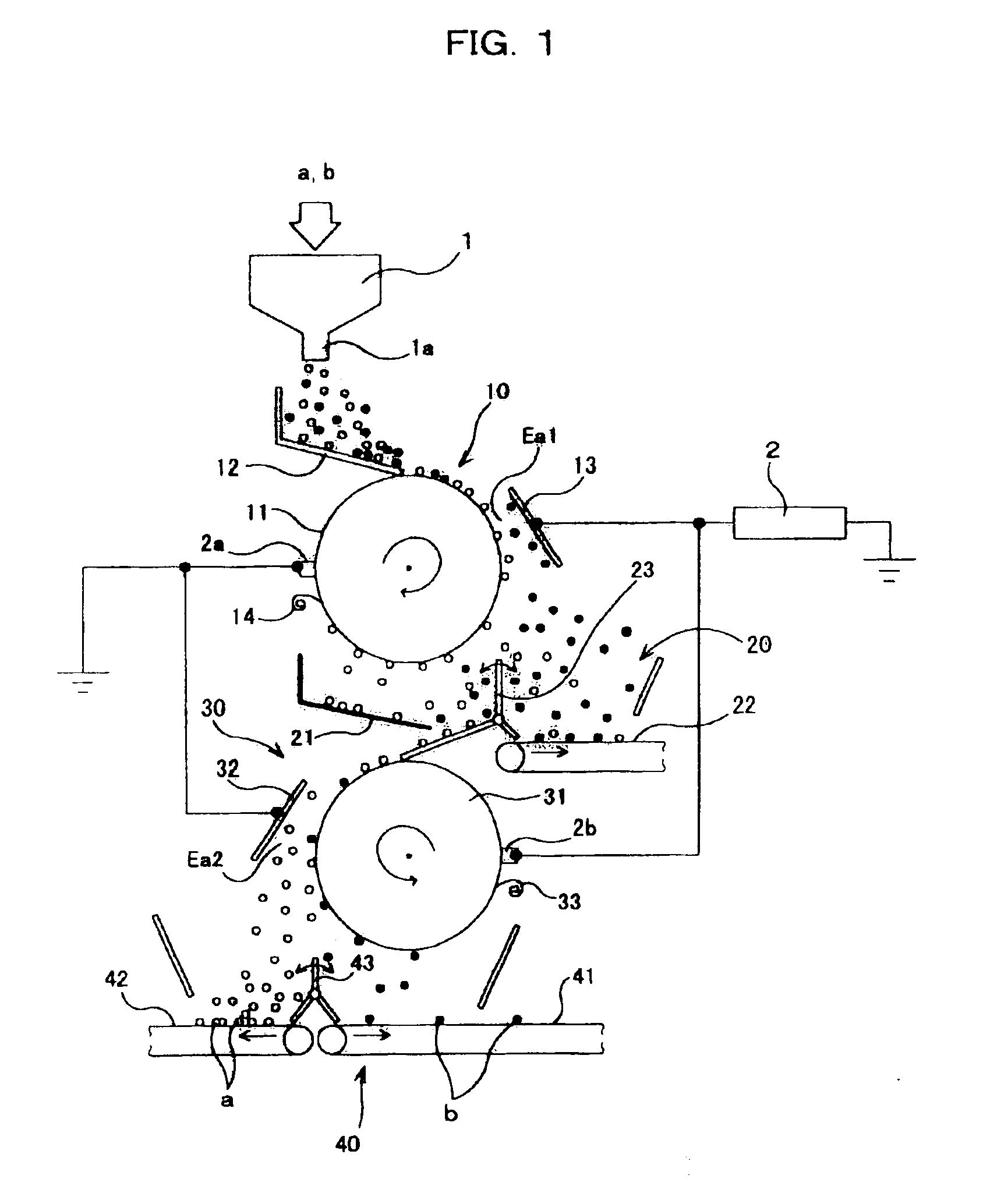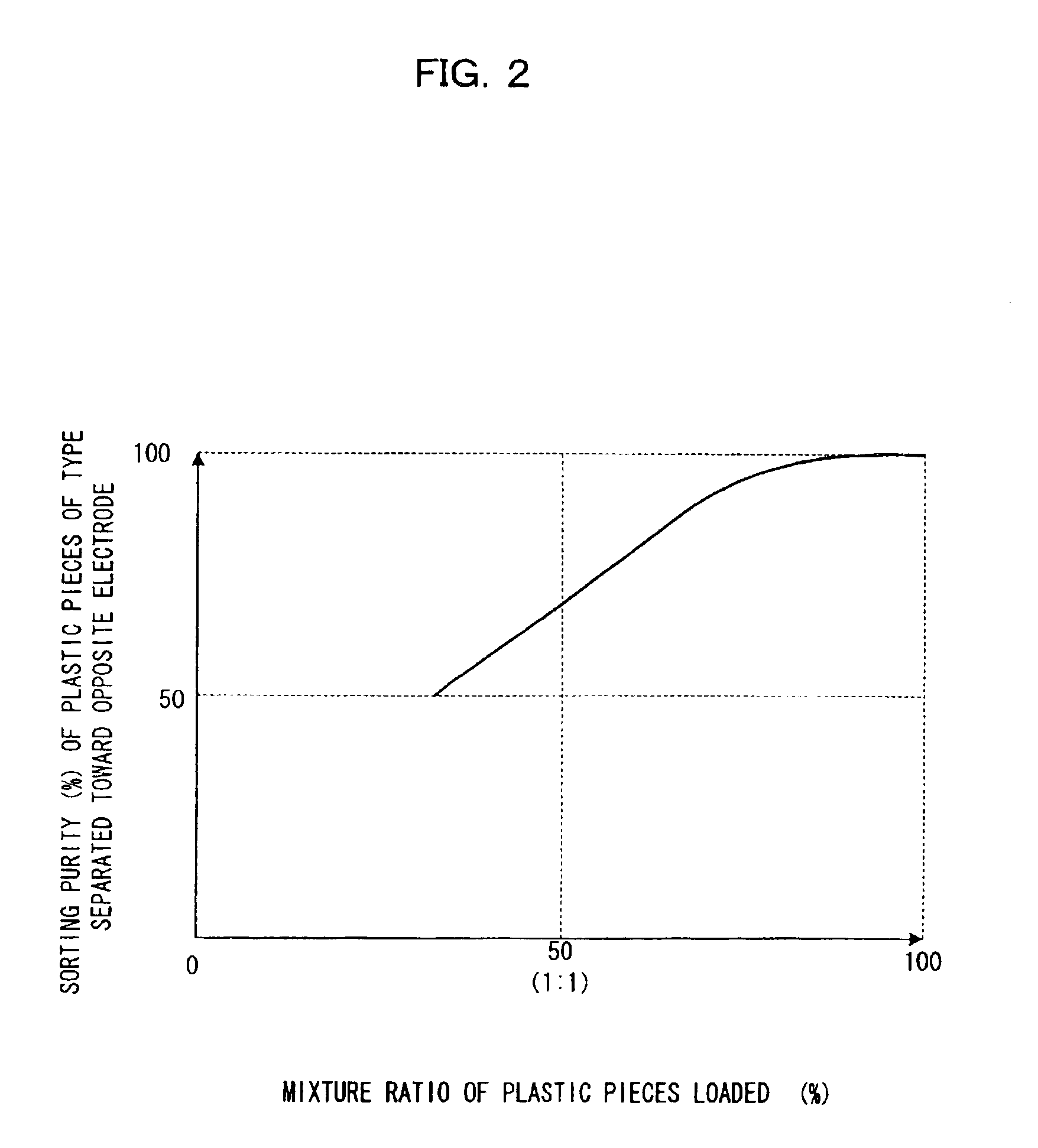Apparatus for separating plastic chips
a sorting apparatus and plastic chip technology, applied in the direction of electrostatic separation, solid separation, chemical apparatus and processes, etc., can solve the problems of affecting continuous processing, affecting the quality of plastic chips, and affecting the separation performance, etc., to achieve high purity and high recovery rate
- Summary
- Abstract
- Description
- Claims
- Application Information
AI Technical Summary
Benefits of technology
Problems solved by technology
Method used
Image
Examples
first embodiment
[0028]First, a plastic sorting apparatus according to the present invention will be described with reference to FIGS. 1 and 2.
[0029]This plastic sorting apparatus comprises a tribo-electrifying device 1 that stirs at least two different types (materials) of plastic pieces (for example, plastic crushed waste to be sorted out) a and b mixed together to frictionally contact the different types of plastic pieces a and b with each other in order to tribo-electrify the plastic pieces to respective polarities and electrification amounts in accordance with their order in an electrification array, an upper-stage electrostatic separating section 10 arranged below an exit 1a of the tribo-electrifying device 1 to electrostatically separate the plural types of plastic pieces a and b from each other, and a lower-stage electrostatic separating section 30 arranged below the upper-stage electrostatic separating section 10 to further electrostatically separate one of the plural types of plastic piece...
second embodiment
[0047]According to the above described second embodiment, plastic pieces a and b separated toward the lower-stage upper-level opposing electrode 52 in the lower-stage upper-level electrostatic sorting section 50 are fed to the lower-stage lower-level electrostatic separating section 70 via the lower-stage loading chute 61 of the lower-stage connection section 60. At this time, most of the plastic pieces a and b are plastic pieces a separated by the lower-stage upper-level electrostatic separating section 50 of the upper-stage electrostatic separating section 10 and most of which have been electrified to (+). These plastic pieces a are mixed with plastic pieces b slightly electrified to (−). When the plastic pieces a and b are fed to the lower-level lower-stage electrostatic sorting section 70, a large amount of plastic pieces a are separated and collected on the separation and take-out conveyor 42 with a high purity and a high recovery rate, the conveyor 42 being located closer to t...
third embodiment
[0049]Moreover, a plastic sorting apparatus will be described with reference to FIG. 4. The same members as those in the above embodiments are denoted by the same reference numerals, and their description is thus omitted.
[0050]In the first embodiment, plastic pieces a (including a small amount of plastic pieces b) separated toward the upper-stage drum electrode 11 in the upper-stage electrostatic separating section 10 are fed to the lower-stage electrostatic separating section 30 via the upper-stage connection section 20. In this third embodiment, however, plastic pieces b (including a small amount of plastic pieces a) separated toward the upper-stage opposing electrode 13 in the upper-stage electrostatic separating section 10 are fed to the lower-stage electrostatic separating section 90 via the upper-stage connection section 80.
[0051]The upper stage connection section 80 comprises an upper-stage loading chute 81 that receives and feeds plastic pieces a and b separated toward the u...
PUM
| Property | Measurement | Unit |
|---|---|---|
| Polarity | aaaaa | aaaaa |
| Electrostatic field | aaaaa | aaaaa |
Abstract
Description
Claims
Application Information
 Login to View More
Login to View More - R&D
- Intellectual Property
- Life Sciences
- Materials
- Tech Scout
- Unparalleled Data Quality
- Higher Quality Content
- 60% Fewer Hallucinations
Browse by: Latest US Patents, China's latest patents, Technical Efficacy Thesaurus, Application Domain, Technology Topic, Popular Technical Reports.
© 2025 PatSnap. All rights reserved.Legal|Privacy policy|Modern Slavery Act Transparency Statement|Sitemap|About US| Contact US: help@patsnap.com



